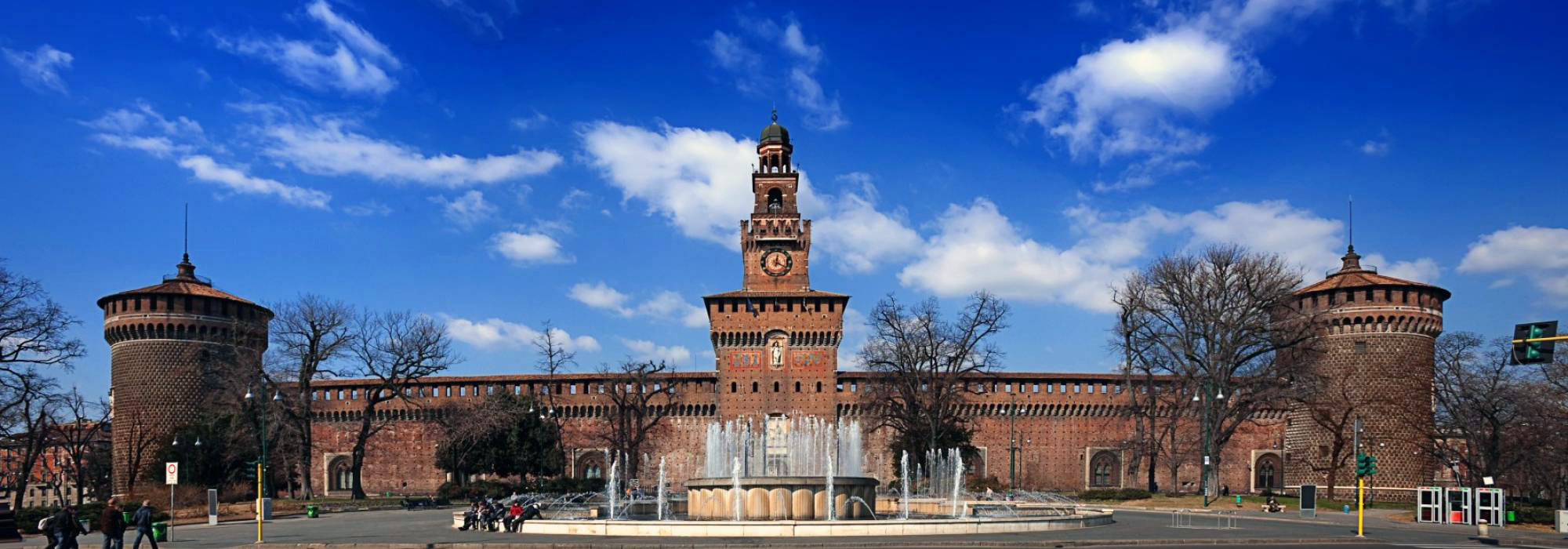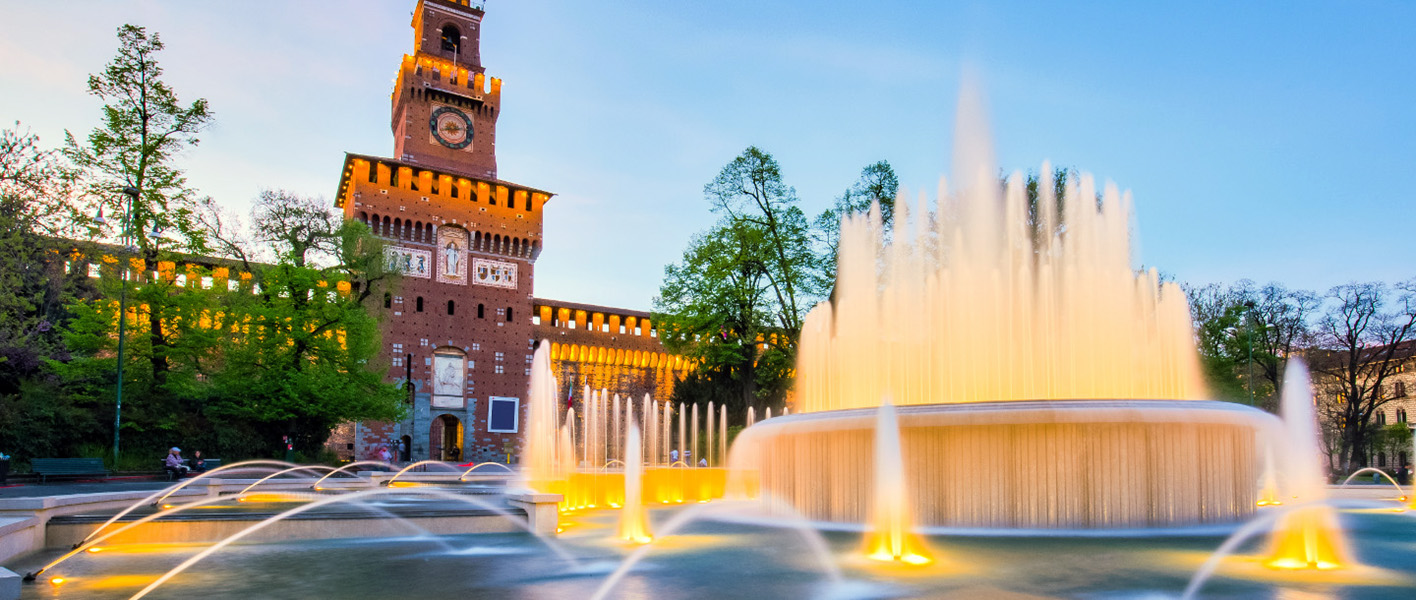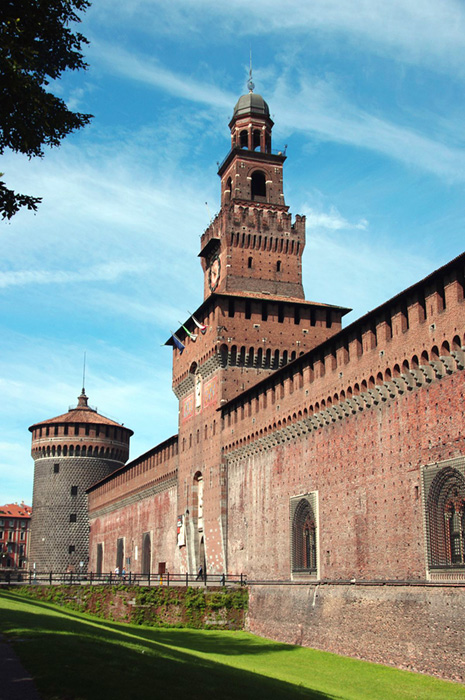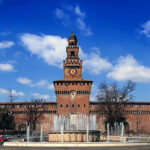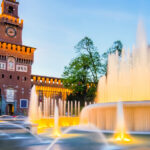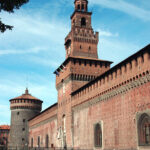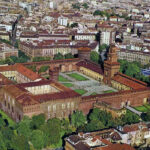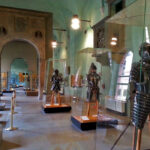Milan – The Sforza Castle
For centuries, Milanese people saw the Castle as a symbol of tyranny and foreign rule. Throughout its long history, citizens attempted to attack and demolish the hated building. It wasn’t until the Unification of Italy, when the Castle transformed into a center of culture, that it became beloved by Milanese people and a symbol of the city.
The Visconti Fortress of “Porta Giovia”
Galeazzo II Visconti, the Lord of the western zone of Milan, built a fortress between 1360 and 1370 that straddled the medieval walls, incorporating the postern gate of Porta Giovia or Zobia. His successor, Gian Galeazzo, added buildings for the paid troops’ lodgings in 1392. The two parts of the structure were separated by the moat of the medieval wall, the so-called “dead moat,” and were only later connected by Filippo Maria, the last of the Visconti. It was during this period that the Castle, the largest of those built by the Visconti, with a square plan of about 180 meters per side, equipped with four square towers and a wide enclosure, became a residence. The uncultivated fields on the northwest side were transformed into a “zardinum” or “barcho.”
The last Lord of the dynasty spent a solitary existence here, confining himself with the court in the immense dwelling in which he died without legitimate heirs. Indeed, he left only one daughter, Bianca Maria, legitimized by Emperor Sigismondo in 1426 and married in 1441 to the condottiero Francesco Sforza, called upon by Filippo Maria Visconti to defend the Duchy against the Venetians.
In 1447, upon Filippo Maria’s death, the Milanese people proclaimed the Ambrosian Republic, and the Porta Giovia residence, a symbol of the lordly power, was partially damaged.
The Visconti Fortress still has the gray serizzo stone base on the dead moat and on the external sides of the Rocchetta and the Ducal Court.
The Sforza Castle Rises
The captain of fortune from Romagna, Francesco Sforza, a man of great military ability and notable political skill, already defense of Milan at Filippo Maria Visconti’s pay, besieged the city, in turn, managing in the end to be welcomed by the Milanese people as a liberator. On March 25, 1450, Sforza and his consort, Bianca Maria Visconti, were acclaimed by the people as Lords of Milan.
Having taken power, he immediately set about renewing the Visconti Castle. Knowing the Milanese people’s hatred towards the ancient building, Francesco Sforza justified the reconstruction with the desire to beautify the city and ensure its defense against external enemies.
Consistently, in 1452, he appointed alongside the military engineers Giovanni da Milano, Jacopo da Cortona, Marcoleone da Nogarolo, a civil architect, the Florentine Antonio Averulino, also known as Filarete, tasked with designing the façade facing the city, with the tall central entrance tower. However, the Tuscan architect was soon removed, and the works passed under the direction of the military architect Bartolomeo Gadio, Sforza’s trusted man, from 1452. Commissioner for the fortresses of the Duchy, Gadio modified the city-facing façade by adding two massive round-angled towers with diamond-point serizzo cladding, more suitable to resist the new artillery of the time. On the opposite side, he fortified and expanded the “Ghirlanda,” an existing curtain wall from the Visconti age that, equipped with two round towers at the corners and a covered road, defended the Northern front.
The completion and enrichment works of the Castle intensified with Francesco Sforza’s successor. From 1468, Galeazzo Maria, the eldest son, moved to the Castle with his wife Bona di Savoia, sister-in-law of the King of France, Louis XI, and with his court. In a few years, the Rocchetta and the Ducal Court were completed, the halls were frescoed, and the Ducal Chapel was built and decorated.
The Castle presented itself at this time with the large Arms Courtyard, surrounded by buildings, while towards the park, there were the Ducal apartments and the Rocchetta, a fortified square complex.
Ludovico il Moro
Galeazzo Maria died in December 1476 due to a conspiracy. His widow, Bona, then assumed regency for her young son, Gian Galeazzo Maria, and in 1477 she had the central tower of the castle – which still bears her name today – raised in order to control the entire fortress.
However, Galeazzo Maria’s brother, Ludovico Maria, known as il Moro, quickly seized power and exiled Bona. Cultured and a lover of the arts, il Moro invited great artists to the Milanese court, which became one of the most refined of the era, including Donato Bramante and Leonardo da Vinci, whose Sala delle Asse can still be admired today. In 1490, he commissioned Bartolomeo Suardi, known as Bramantino, to decorate the Sala del Tesoro.
The work to make the castle increasingly luxurious was interrupted in 1497, when il Moro’s wife, Beatrice d’Este, died in childbirth and French troops approached Milan. Il Moro prepared to resist the enemy attack by cleaning the moats, covering the ravelins, filling the walls of the curtains, gathering supplies, ammunition, and artillery inside. However, fearing a popular uprising, il Moro sought refuge with the court of Emperor Maximilian I of Austria, leaving the castellan to guard the dwelling. After various vicissitudes, which led him to reconquer Milan in 1500, Ludovico il Moro died as a prisoner in France in 1508.
The Castle, the French, and the Spaniards
After falling under French rule in 1499, the Duchy of Milan was contested between the French, the German Emperor, and the Sforza for thirty years. These were difficult years for the city and the castle. During the French domination, in June 1521, the Filarete Tower, transformed into a munitions depot, exploded, causing damage to the surrounding walls. The castellan died in the incident. When Francesco II Sforza, the Moro’s second son, returned to power, the castle, suitably restored but now without the entrance tower, hosted the wedding between the Sforza and Christina, daughter of the Danish sovereign, celebrated on May 3, 1534.
After this lavish event, the building definitively lost its aristocratic character.
The last Sforza left the Spanish Emperor Charles V as the heir to the Duchy.
The Spanish fortress
From 1549, Don Ferrante Gonzaga, the general captain and lieutenant of the Emperor, promoted a significant defense work, which surrounded Milan and protected the castle with a twelve-pointed star-shaped fortification, the most advanced for the era in terms of fortifications. The ancient Sforza residence became home to a large garrison. Within the building’s enclosure, as we know from literary testimonies and iconographic sources, one could find a pharmacy, a hospital, shops, a bakery, two ovens, a tavern, a nevera for preserving ice, two churches, and vast deposits. The work and maintenance of the garrison were borne by the Milanese.
Testimony of the Spanish presence in the castle includes: the ancient hospital, now the Museo della Pietà Rondanini; the painted insignia of Don Suarez de Figueroa, the castle governor of Philip II, still visible in Room II of the ducal apartments; and the coats of arms that decorate the ceiling of Room VII celebrating the wedding between Philip II and Mary Tudor (1555). These two rooms are part of the Museum of Antique Art.
The Austrian Fortress
During the War of Spanish Succession, in 1706 Eugenio di Savoia conquered Milan on behalf of Emperor Giuseppe I of Habsburg. There were no significant changes regarding the Castle, except for the change in nationality of the occupants. The Sforza rooms continued to deteriorate, with damages to the ceilings, frescoes, and stucco decorations. The white statue of Saint John of Nepomuk, the Bohemian patron saint of the Austrian armies, commissioned in 1727 by Giovanni Dugnani, was the only testimony to the Austrian domination in the Castle. It was requested by the fortress commander Annibale Visconti and located in the Arms Courtyard, near the entrance to the Ducal Court.
Napoleonic Armies Attack
The approach of Napoleon Bonaparte to Milan led to the withdrawal of the city by Archduke Ferdinand I of Austria. On May 9, 1796, only 2000 guards remained in the Castle with 152 cannons, 3000 pounds of explosive powder, 11000 rifles, and 100 cattle. A group of pro-French Milanese attempted to attack the hated fortress, likened to the famous Bastille, but were repelled by General Lamy and his garrison. However, by the end of June, the Castle was in French hands. The new occupants designated it as housing for about 4000 men. The return of the Austrians and the subsequent Napoleonic victory in Marengo on June 14, 1800, did not change the fate of the complex as a barracks. The Ducal Chapel had become a sadly melancholic stable.
Napoleonic Transformations
The dismantling of the star-shaped citadel around the Castle, begun in 1801, created a large empty space around the building for which architects such as Luigi Canonica and Giovanni Antolini developed projects. The latter came up with the idea of an immense semicircular square, the Foro Bonaparte, adorned with public buildings in a classic form. Even for the Castle, intended as the seat of the government, a classicizing appearance and a colonnaded atrium were foreseen. The laying of the cornerstone took place in April 1801, but the work was immediately interrupted.
An Enemy Fortress
The establishment of the Lombardo-Venetian Kingdom following Napoleon’s fall brought the Austrians back to Milan in 1815. The Castle continued to serve as a barracks, while the empty space behind it, the Piazza d’Armi, became a venue for military parades.
During the Five Days of Milan (March 18-22, 1848), the Castle was a prison for Milanese citizens arrested by the Austrians and the site from which Radetzky bombed the city. After the withdrawal of the Habsburg troops, bodies of men and women were found in Castle piled up at various points. The Milanese, who regained possession of the city for four months, lowered the round towers. The final end of Austrian rule came in 1859. The Castle was attacked and plundered by the Milanese, who took away weapons, furniture, and money intended for the troops.
Luca Beltrami’s Renovations
After conflicting opinions on what to do with the Castle, including the proposal by Angelo Colla (1882-1884) to transform it into a Gothic-style structure, it was finally decided to preserve the ancient building.
In 1893, a complex restoration and reconstruction of the Castle began, which had been reduced to a barracks for centuries. Under the direction of Luca Beltrami, the demolition of the Ghirlanda and the Cavallerizza, a 19th-century construction, began as early as August 1892. The Carmine and Santo Spirito doors were reopened, the two towers were raised, and the Bona Tower was restored to its original appearance. The entire city of Milan participated in a public fundraiser to restore the complex to its former glory. These were years of intense work, during which non-original structures were eliminated, and ancient traces were investigated. Windows in terracotta and significant traces of Sforza paintings reemerged. The painted decorations in the Hall of Axes and the Treasure Room were rediscovered. The Rocchetta and Ducal Court were restored to their original forms and used to host museums and cultural institutions.
Luca Beltrami’s commitment found the highest expression in the reconstruction of the Castle’s facade facing the city and, above all, of the Torre del Filarete, whose forms the architect reconstructed using a painting from the Leonardesque school (the Madonna Lia) and a graffito found in the Pozzobonelli farmhouse. The towers of the castles of Vigevano and Cusago were also used as a model for what was a total but philologically, at least according to the conceptions of the time, correct reconstruction. Before proceeding with the reconstruction, the architect produced a life-size wooden model in 1895. The reconstructed tower, dedicated to King Umberto I, was solemnly inaugurated on September 24, 1905.

